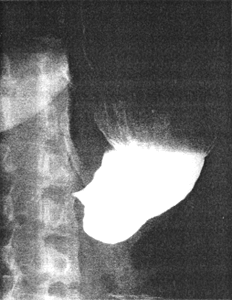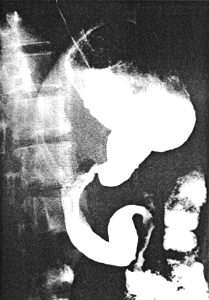



Go to chapter: 1 | 2 | 3 | 4 | 5 | 6 | 7 | 8 | 9 | 10 | 11 | 12 | 13 | 14 | 15 | 16 | 17 | 18 | 19 | 20 | 21 | 22 | 23 | 24 | 25 | 26 | 27 | 28 | 29 | 30 | 31 | 32 | 33 | 34 | 35 | 36 | 37 | 38 | 39
Chapter 39 (page 197)
The following cases are examples of acid corrosive injuries:
Case Reports
Case 39.1 L.M., female aged 29 years, accidentally swallowed a cupful of
hydrochloric acid. This was followed by burning restrosternal and epigastric pain and
continuous vomiting. Radiographic examination a week later revealed no abnormality in
the oesophagus. A severe stricture, causing almost total occlusion of the lumen and
commencing as a funnel-shaped narrowing in the region of the incisura angularis, was
seen in the distal third of the stomach (Fig 39.1). At times a trickle of barium traversed
the stricture, which was constant; the sphincteric cylinder and pyloric aperture were
unidentifiable, with total absence of cyclical contraction and relaxation. Repeat
examination after another week showed similar features, although the stricture appeared
to be somewhat less severe. Antrectomy and Billroth I anastomosis 3 weeks after the
incident showed the distal 5.0 to 6.0cm of the stomach to be oedematous and stenotic;
the duodenum appeared normal. Microscopically severe fibrotic change was seen in the
submucosa, with areas of necrosis and partial regeneration in the mucosa.
 |
Fig. 39.1.
Case L.M. Funnel-shaped, severe stricture in distal stomach
|
Case 39.2 D.P., 23 year old male, swallowed half a tumblerful of hydrochloric acid
in an attempted suicide. After some hours he was admitted to a peripheral hospital where
gastric lavage with dilute alkali was performed. Dysphagia and continuous vomiting
necessitated oesophagoscopy after 10 days. This showed mucosal erosions and moderate
oesophageal stenosis at 33cm. Upper gastrointestinal barium examination revealed a
constant narrowing of the distal third of the stomach with absent cyclical contraction and
relaxation of the pyloric sphincteric cylinder (Fig 39.2). This was associated with a
patent pylorus and rapid emptying of fluid barium. The entire duodenum showed loss of
mucosal pattern with rigid walls; immediately beyond the duodeno-jejunal flexure a
3.0cm long stenotic area was evident.
 |
Fig. 39.2.
Case D.P. Constant narrowing distal third of stomach. Pyloric aperture
patent. Absent cyclical activity of pyloric sphincteric cylinder. Duodenal walls rigid.
Stenosis proximal jejunum
|
As can be expected, the above cases show that acid corrosive injury of the stomach is not
contained by anatomical boundaries, and therefore not necessarily limited to the pyloric
sphincteric cylinder or to the pyloric mucosal zone. Usually the walls of the cylinder are
damaged as part of a more extensive injury; the result is that the pyloric sphincteric
cylinder is no longer recognizable as a functional unit. In Case 39.1 the cylinder was
almost totally occluded as part of a more extensive stricture, causing obstruction to the
flow of fluid barium. In Case 39.2 partial contraction of the cylinder "fixed" the pyloric
aperture in the open position, leading to rapid emptying of fluid barium; theoretically the
lack of cyclical contraction of the cylinder in this case should hamper trituration (Chap
18) and delay the emptying of solids (Chap 18).
A consequence of corrosive injury of the pyloric mucosal zone is that gastrin producing
G-cells in this location may be affected, leading to a histamine-fast achlorhydria.
It is probable that cells producing other
regulatory peptides, e.g. somatostatin, vasoactive intestinal peptide and enkephalin (Chap
9) will also be damaged.
Previous Page | Table of Contents | Next Page
© Copyright PLiG 1998








